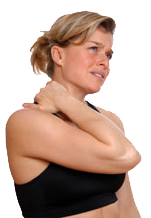The benefits of therapeutic massage are varied and many. They have been appreciated by people in just about every culture on earth since the dawn of time. Today, people who suffer from the following conditions, as well as many others, are taking a proactive approach to protecting and enhancing their health by receiving therapeutic massage on some regular basis. Do you or someone you know need relief from one or more of the following?
Stress: Therapeutic massage is one of the best-known antidotes for stress because it reduces anxiety, increases energy and improves one’s outlook on life. It can also relieve symptoms of asthma and insomnia as well as provide excellent supportive therapy for those in psychological counseling or treatment for addiction. (To measure your current stress level and susceptibility to stress-related illness, click here.)
 Tight/painful muscles: Massage relieves many forms of soft tissue discomfort including such things as cramps, clenched jaw, stiff neck, aching shoulders and backs via stretching and kneading techniques. It also stimulates the nervous system which, in turn, “instructs” the muscles to relax even more.
Tight/painful muscles: Massage relieves many forms of soft tissue discomfort including such things as cramps, clenched jaw, stiff neck, aching shoulders and backs via stretching and kneading techniques. It also stimulates the nervous system which, in turn, “instructs” the muscles to relax even more.
Delayed muscle soreness: Massage flushes out built-up metabolic waste such as lactic acid as well as many other toxins taken in from our environment that accumulate, over time, in our muscles. Vigorous exercise “magnifies” the negative effects of the build-up. Massage often minimizes, if not totally eliminates, the delayed soreness.
Injuries: Massage has been known to speed the healing of injuries such as tendonitis, ligament sprains and muscles strains. It reduces inflammation by increasing blood circulation and reducing swelling at the injury site. Some techniques can even minimize new scar formation and reduce or make more pliable scar tissue from old injuries.
 Secondary pain: Massage can reduce secondary, (ie. associated or related pain), such as headaches from eyestrain, low back pain from pregnancy and the pain incurred by healthy muscles having to overcompensate for the incapacitation of other muscles at the site of an injury.
Secondary pain: Massage can reduce secondary, (ie. associated or related pain), such as headaches from eyestrain, low back pain from pregnancy and the pain incurred by healthy muscles having to overcompensate for the incapacitation of other muscles at the site of an injury.
Prevention of new injuries: Massage loosens muscles that might otherwise become injured due to the over stressing of unbalanced muscle groups, failure to warm up or stretch “cold” muscles before engaging in strenuous activities and/or favoring or forcing already painful or restricted muscles.
Pain or restriction in joints: Massage works directly and indirectly on joints to improve blood circulation and mobility. It also stimulates the production of natural lubrication and relieves pain from conditions such as osteoarthritis.
Posture: Massage releases restrictions in muscles, joints, and our muscle’s tough connective coverings thereby returning the body to a more natural, relaxed posture. It can relieve the pain associated with spinal curvatures such as scoliosis.
 Negative effects of forced inactivity: Massage relieves the aches and pains resulting from limited physical activity caused by injury, surgery, poor ergonomics on the job, paralysis or even normal aging.
Negative effects of forced inactivity: Massage relieves the aches and pains resulting from limited physical activity caused by injury, surgery, poor ergonomics on the job, paralysis or even normal aging.
Fluid retention: Massage drains the tissues of excess fluid, via the lymph system, that often builds up as a result of pregnancy, recent injury or surgery.
